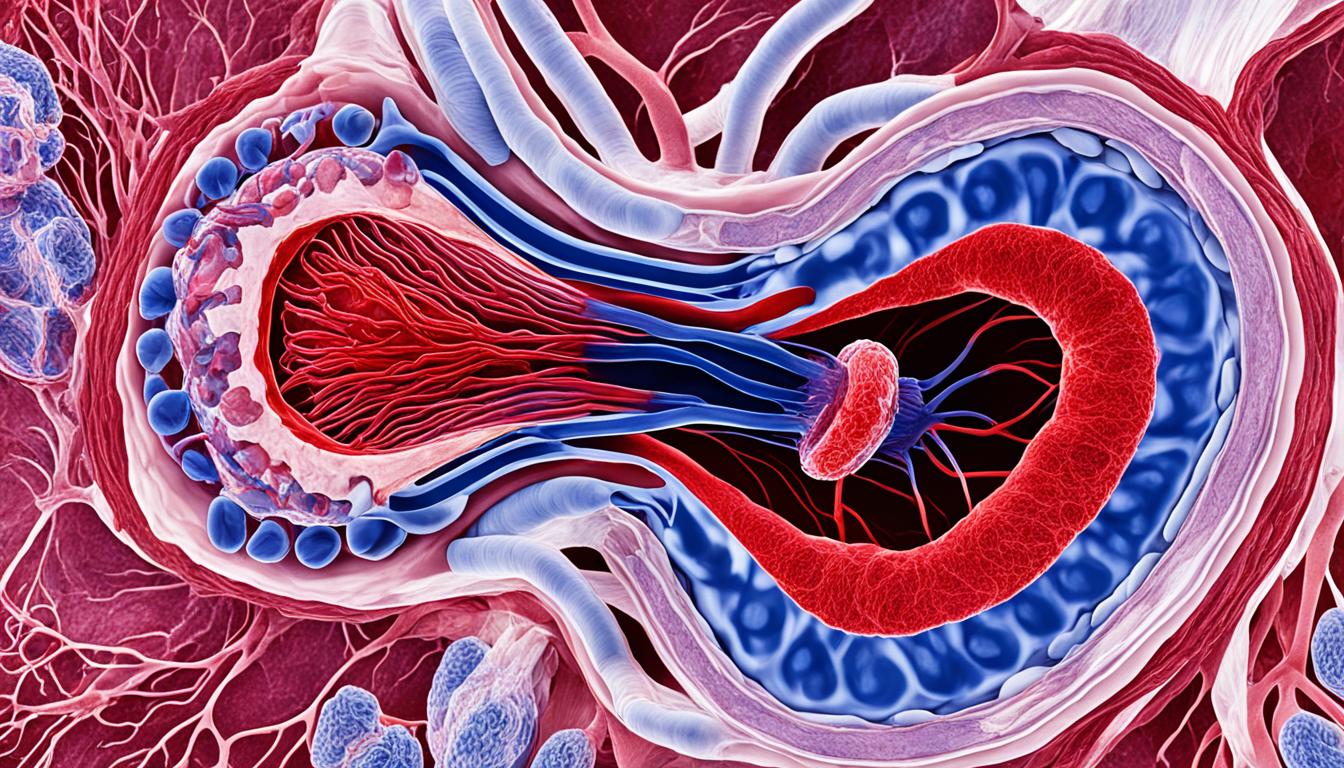Aortic stenosis is a common heart valve disease that’s bad news for the heart. It makes the aortic valve narrow. This blocks the smooth movement of blood rich in oxygen and nutrients. Ignoring it can cause deadly issues. Signs that you might have it include chest pain, coughing, feeling dizzy, passing out, or showing signs of heart failure.
This heart issue can happen because of heart defects from birth, buildups on the heart valves, and rheumatic fever. The older you get, especially over 65, the more likely you are to get it. Also, it hits men harder than it does women.
Doctors check if you have aortic valve stenosis by looking at your symptoms, history, and tests like an ECG or echocardiogram. You might get different treatments like medicines to feel better, a surgery to widen the valve, or a new valve altogether. Lifestyle changes, such as eating well, exercising, and not smoking, are also key to keeping it at bay.
Key Takeaways:
- Aortic stenosis is a common type of heart valve disease, characterized by the narrowing of the aortic valve.
- The main symptoms of aortic stenosis include chest pain, coughing, lightheadedness, fainting, and signs of heart failure.
- Congenital heart defects, calcification or cholesterol plaques, and rheumatic fever are the main causes of aortic valve stenosis.
- Diagnosis involves a combination of symptoms, medical history, and tests such as electrocardiogram and echocardiography.
- Treatment options include medication, percutaneous balloon dilatation, and open valve replacement surgery.
Signs and Symptoms of Aortic Stenosis
In the beginning, aortic stenosis often shows no signs. But as the valve narrows, symptoms can start. Knowing these signs early on can lead to better treatment.
Common Symptoms
- Chest pain: Aortic stenosis can cause chest pain, called angina. Pain might show up when you’re active or stressed.
- Coughing: A cough, sometimes with blood, can signal aortic stenosis. This worsens as the condition gets bad.
- Lightheadedness: Feeling dizzy or light-headed is common with aortic stenosis. It happens when the heart can’t pump enough blood.
- Fainting: In severe cases, people might faint due to low brain blood flow.
Signs of Heart Failure
Heart failure’s signs can show up later in aortic stenosis. The heart can’t pump blood well. Symptoms of this include:
- Shortness of breath: You might feel breathless with aortic stenosis, especially when active or in bed.
- Fatigue: Being really tired, even after small tasks, might point to heart failure with aortic stenosis.
- Swelling: Fluid buildup can cause swelling in the legs or belly.
Some people may have no symptoms early on. Regular health check-ups are key for spotting aortic stenosis before symptoms start. Early diagnosis is essential for effective treatment and better health outcomes.
| Symptoms | Signs |
|---|---|
| Chest pain | Shortness of breath |
| Coughing (sometimes with blood) | Fatigue |
| Lightheadedness | Swelling (edema) |
| Fainting | – |
Causes and Risk Factors of Aortic Valve Stenosis
Aortic valve stenosis is the narrowing of the aortic valve. It can be caused by various factors. This condition poses important health risks. It’s key to know the causes and risk factors for fast diagnosis and good care.
Congenital Heart Defects
At birth, some people have heart defects that affect valve function. These defects can make the aortic valve narrow and wear out, causing aortic stenosis.
Calcification or Cholesterol Plaques
As people age, cholesterol and calcium can build upon the aortic valve. This makes the valve stiff and blood flow hard. Over time, it causes aortic stenosis to occur.
Rheumatic Fever
Untreated pharyngitis, or a sore throat, can lead to rheumatic fever. It can harm the heart valves, including the aortic valve. If not treated, it can cause aortic stenosis and heart failure.
Other Risk Factors
There are other reasons aortic stenosis may develop. These include:
- A family history of aortic valve disease
- Chronic kidney disease
- Medical conditions like diabetes, high blood pressure, and high cholesterol
Finding and fixing these risk factors early can prevent and treat aortic stenosis.
Knowing about aortic stenosis helps you lower your risk. It tells you when to get medical help and how to live healthier. It’s vital to get checked and screened to catch and manage this illness early.
| Common Causes and Risk Factors of Aortic Valve Stenosis | |
|---|---|
| Congenital Heart Defects | Abnormalities in the structure of the heart valves present at birth |
| Calcification or Cholesterol Plaques | Build-up of calcium or cholesterol deposits on the aortic valve |
| Rheumatic Fever | Inflammatory condition leading to heart valve damage |
| Family History | Having a close relative with a history of aortic valve disease |
| Chronic Kidney Disease | Impaired kidney function contributing to the development of aortic stenosis |
| Medical Conditions | Diabetes, high blood pressure, and high cholesterol increasing the risk of aortic valve narrowing |
Treatment and Prevention of Aortic Valve Stenosis
Treating aortic valve stenosis depends on how serious it is and its effect on health. Doctors may give medicines to help with symptoms and avoid heart failure. When the narrowing is severe and the patient is showing symptoms, they might need surgery.
This surgery means replacing the narrowed heart valve with a new one. This makes sure the blood flow is normal again. For those who can’t have surgery or need a short-term fix, they might use percutaneous balloon dilatation.
It’s a less invasive process using a balloon to stretch the narrowed valve. This improves blood flow but might not last forever. More treatments later might be needed.
Staying healthy is the best way to avoid heart problems like aortic stenosis. A balanced diet, regular exercise, and not smoking are vital. These steps lower the risk of aortic stenosis and boost your heart’s health.
Remember to have regular health check-ups and screenings too. They help catch problems early, so treatment can start quickly if needed.

